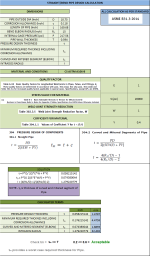PIPE_DESIGN_CALCULATIONS - ASME B31.3

Description
Calculation Reference
PIPE DESIGN CALCULATIONS
ASME B31.3
ANSI B31
ASME B31.3 is the Process Piping code, which provides the requirements for the design, fabrication, assembly, erection, inspection, examination, and testing of process piping systems. This code is intended for use in the chemical, petroleum, pharmaceutical, textile, paper, semiconductor, cryogenic, and other processing industries.
When designing a piping system according to ASME B31.3, several factors need to be considered, including pipe wall thickness, pressure and temperature ratings, branch connections, expansion and flexibility, and support spacing. Here are some key calculations for designing a piping system according to ASME B31.3:
- Pipe wall thickness: The minimum required wall thickness for a pipe can be calculated using the formula:
t = (P * D) / (2 * S * E + P * Y)
where:
- t is the minimum required wall thickness (mm or in)
- P is the internal design pressure (MPa or psi)
- D is the outside diameter of the pipe (mm or in)
- S is the allowable stress for the pipe material at the design temperature (MPa or psi)
- E is the longitudinal weld joint quality factor (dimensionless)
- Y is the coefficient that accounts for material strength variation in the hoop and axial directions (dimensionless)
-
Pressure and temperature ratings: Select the appropriate flange, valve, and fitting ratings for the design pressure and temperature based on ANSI/ASME B16 standards and the piping material.
-
Branch connections: Design branch connections, such as tees, olets, or reinforced nozzles, considering the reinforcement requirements specified in ASME B31.3, Para. 304.3.3.
-
Expansion and flexibility: Evaluate the piping system's thermal expansion and flexibility using ASME B31.3, Appendix D, and determine the appropriate expansion loops, bends, or expansion joints needed to accommodate the thermal growth.
-
Support spacing: Determine the appropriate spacing between pipe supports based on factors such as pipe size, material, and operating conditions. ASME B31.3 does not provide specific support spacing guidelines, but industry practices and other codes (e.g., ASME B31.1) can be used as a reference.
-
Stress analysis: Perform a stress analysis of the piping system to ensure that stresses due to pressure, weight, thermal expansion, and other loads are within the allowable limits specified in ASME B31.3.
Keep in mind that this is just an overview of the key calculations and factors to consider when designing a piping system according to ASME B31.3. For a complete understanding of the requirements, it is essential to refer to the code itself and any applicable addenda, interpretations, or revisions.
Calculation Preview
Full download access to any calculation is available to users with a paid or awarded subscription (XLC Pro).
Subscriptions are free to contributors to the site, alternatively they can be purchased.
Click here for information on subscriptions.

